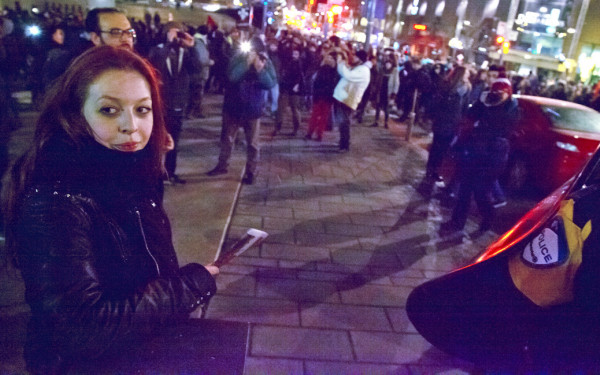Protests Continue Over Education Summit
Thousands March Against Tuition Indexation, Twelve Arrested
Visit our Photo Blog for more pictures from the demonstration.
With the Summit on Higher Education unfolding behind closed doors Feb. 25 and Feb. 26, roughly 5,000 student protesters returned to the streets, decrying funding cuts and plans for an indexation of tuition fee rates by three per cent.
Organized throughout the two-day conference, the demonstrations continuously grew in size, culminating in a crowd of at least 4,000 marching Tuesday afternoon.
But while the crowds grew steadily, tensions between protesters and the police did too.
Tuesday’s protest, which appeared to be the largest gathering of students since the general strike last summer, was marred by confrontation between the two sides.
The demonstration was organized by the Association pour une solidarité syndicale étudiante, in response to a January announcement by Education Minister Pierre Duchesne that took the possibility of free post-secondary education off the table at the summit.
The federation instead launched an ultimatum that saw it boycott the summit itself and instead put its energy into organizing a demonstration against indexation and for free tuition to coincide with the summit’s conclusion.
Pepper spray and sound grenades were utilized to disperse the large crowd, while volleys of snowballs, paint projectiles, glass and even pieces of wood were aimed at police by a small contingent of protesters.
Twelve people were arrested over the course of the day, while only two arrests took place on Monday, according to the Service de police de la Ville de Montréal.
1_900_598_90.jpg)
According to ASSÉ, its student members will not be backing down any time soon.
“This summit only served to confirm a new tuition hike, despite the firm opposition of the university community,” argued ASSÉ spokesperson Jérémie Bédard-Wien, in a press release.
Monday’s protest, which had about a thousand demonstrators and was also broken up by riot police, kept clashes between protesters and police to a minimum—until the demonstration was declared illegal.
That demonstration made several attempts to reach the Arsenal Art Gallery in the Griffintown neighbourhood, where the provincial Summit on Higher Education was taking place.
A smaller gathering of about a dozen university professors also took place outside the summit’s location earlier that morning.
For François Genest, a former Concordia computer science professor who spoke at the morning demonstration, no podium or protest is too small.
“It’s about using all avenues and spaces to speak up,” he explained.
“I don’t know if I should feel sometimes if it makes a difference,” he admitted. “It can be we are not heard out here by the politicians [inside the summit].”

1_900_600_90.jpg)
_600_832_s.png)

_600_375_90_s_c1.jpg)
5_600_375_90_s_c1.jpg)

_600_375_90_s_c1.jpg)